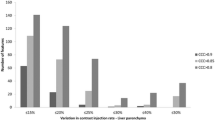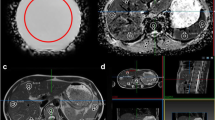Abstract
Objectives
To assess the precision of MRI radiomics features in hepatocellular carcinoma (HCC) tumors and liver parenchyma.
Methods
The study population consisted of 55 patients, including 16 with untreated HCCs, who underwent two repeat contrast-enhanced abdominal MRI exams within 1 month to evaluate: (1) test–retest repeatability using the same MRI system (n = 28, 10 HCCs); (2) inter-platform reproducibility between different MRI systems (n = 27, 6 HCCs); (3) inter-observer reproducibility (n = 16, 16 HCCs). Shape and 1st- and 2nd-order radiomics features were quantified on pre-contrast T1-weighted imaging (WI), T1WI portal venous phase (pvp), T2WI, and ADC (apparent diffusion coefficient), on liver regions of interest (ROIs) and HCC volumes of interest (VOIs). Precision was assessed by calculating intraclass correlation coefficient (ICC), concordance correlation coefficient (CCC), and coefficient of variation (CV).
Results
There was moderate to excellent test–retest repeatability of shape and 1st- and 2nd-order features for all sequences in HCCs (ICC: 0.53–0.99; CV: 3–29%), and moderate to good test–retest repeatability of 1st- and 2nd-order features for T1WI sequences, and 2nd-order features for T2WI in the liver (ICC: 0.53–0.73; CV: 12–19%). There was poor inter-platform reproducibility for all features and sequences, except for shape and 1st-order features on T1WI in HCCs (CCC: 0.58–0.99; CV: 3–15%). Good to excellent inter-observer reproducibility was found for all features and sequences in HCCs (CCC: 0.80–0.99; CV: 4–15%) and moderate to good for liver (CCC: 0.45–0.86; CV: 6–25%).
Conclusions
MRI radiomics features have acceptable repeatability in the liver and HCC when using the same MRI system and across readers but have low reproducibility across MR systems, except for shape and 1st-order features on T1WI. Data must be interpreted with caution when performing multiplatform radiomics studies.
Key Points
• MRI radiomics features have acceptable repeatability when using the same MRI system but less reproducible when using different MRI platforms.
• MRI radiomics features extracted from T1 weighted-imaging show greater stability across exams than T2 weighted-imaging and ADC.
• Inter-observer reproducibility of MRI radiomics features was found to be good in HCC tumors and acceptable in liver parenchyma.





Similar content being viewed by others
Abbreviations
- ADC:
-
Apparent diffusion coefficient
- CCC:
-
Concordance correlation coefficient
- CV:
-
Coefficient of variation
- GLCM:
-
Gray-level co-occurrence matrix
- GLDM:
-
Gray-level dependence matrix
- GLRLM:
-
Gray-level run length matrix
- GLSZM:
-
Gray-level size zone matrix
- HCC:
-
Hepatocellular carcinoma
- IBSI:
-
Image Biomarker Standardization Initiative
- ICC:
-
Intraclass correlation coefficient
- NGTDM:
-
Neighboring gray tone difference matrix
- QIB:
-
Quantitative imaging biomarker
- QIBA:
-
Quantitative Imaging Biomarkers Alliance
- ROI:
-
Region of interest
- T1WIpre:
-
T1-weighted imaging pre-contrast
- T1WIpvp:
-
T1-weighted imaging portal venous phase
- T2WI:
-
T2-weighted imaging
- TE:
-
Echo time
- TR:
-
Repetition time
- VOI:
-
Volume of interest
References
Kumar V, Gu Y, Basu S et al (2012) Radiomics: the process and the challenges. Magn Reson Imaging 30:1234–1248
Lambin P, Rios-Velazquez E, Leijenaar R et al (2012) Radiomics: extracting more information from medical images using advanced feature analysis. Eur J Cancer 48:441–446
Aerts HJWL, Velazquez ER, Leijenaar RTH et al (2014) Decoding tumour phenotype by noninvasive imaging using a quantitative radiomics approach. Nat Commun 5:1–9
Lambin P, Leijenaar RTH, Deist TM et al (2017) Radiomics: the bridge between medical imaging and personalized medicine. Nat Rev Clin Oncol 14:749–762
Sullivan DC, Obuchowski NA, Kessler LG et al (2015) Metrology standards for quantitative imaging biomarkers. Radiology 277:813–825
Hagiwara A, Fujita S, Ohno Y, Aoki S (2020) Variability and standardization of quantitative imaging: monoparametric to multiparametric quantification, radiomics, and artificial intelligence. Invest Radiol 55:601
van Timmeren JE, Cester D, Tanadini-Lang S, Alkadhi H, Baessler B (2020) Radiomics in medical imaging—“how-to” guide and critical reflection. Insights Imaging 11:1–16
Zwanenburg A, Vallières M, Abdalah MA et al (2020) The image biomarker standardization initiative: standardized quantitative radiomics for high-throughput image-based phenotyping. Radiology 295:328–338
Zwanenburg A, Leger S, Vallières M, Löck S (2016) Image biomarker standardisation initiative. arXiv preprint arXiv:161207003
Park JE, Kim D, Kim HS et al (2020) Quality of science and reporting of radiomics in oncologic studies: room for improvement according to radiomics quality score and TRIPOD statement. Eur Radiol 30:523–536
Vallières M, Zwanenburg A, Badic B, Le Rest CC, Visvikis D, Hatt M (2018) Responsible radiomics research for faster clinical translation. Soc Nuclear Med 59:189–193
Heus P, Damen JAAG, Pajouheshnia R et al (2018) Poor reporting of multivariable prediction model studies: towards a targeted implementation strategy of the TRIPOD statement. BMC Med 16:1–12
Traverso A, Wee L, Dekker A, Gillies R (2018) Repeatability and reproducibility of radiomic features: a systematic review. Int J Radiat Oncol Biol Phys 102:1143–1158
Bakr S, Gevaert O, Patel B et al (2020) Interreader variability in semantic annotation of microvascular invasion in hepatocellular carcinoma on contrast-enhanced triphasic CT images. Radiology: Imaging Cancer 2:e190062
Echegaray S, Gevaert O, Shah R et al (2015) Core samples for radiomics features that are insensitive to tumor segmentation: method and pilot study using CT images of hepatocellular carcinoma. J Med Imaging 2:041011
Baessler B, Weiss K, Pinto Dos Santos D (2019) Robustness and reproducibility of radiomics in magnetic resonance imaging: a phantom study. Invest Radiol 54:221–228
Bianchini L, Botta F, Origgi D et al (2020) PETER PHAN: an MRI phantom for the optimisation of radiomic studies of the female pelvis. Physica Med 71:71–81
Fiset S, Welch ML, Weiss J et al (2019) Repeatability and reproducibility of MRI-based radiomic features in cervical cancer. Radiother Oncol 135:107–114
Schwier M, van Griethuysen J, Vangel MG et al (2019) Repeatability of multiparametric prostate MRI radiomics features. Sci Rep 9:9441
Peerlings J, Woodruff HC, Winfield JM et al (2019) Stability of radiomics features in apparent diffusion coefficient maps from a multi-centre test-retest trial. Sci Rep 9:1–10
Mahon RN, Hugo GD, Weiss E (2019) Repeatability of texture features derived from magnetic resonance and computed tomography imaging and use in predictive models for non-small cell lung cancer outcome. Phys Med Biol 64:145007
Bologna M, Corino V, Mainardi L (2019) Virtual phantom analyses for preprocessing evaluation and detection of a robust feature set for MRI-radiomics of the brain. Med Phys 46:5116–5123
Cattell R, Chen S, Huang C (2019) Robustness of radiomic features in magnetic resonance imaging: review and a phantom study. Vis Comput Ind Biomed Art 2:19
Yang F, Dogan N, Stoyanova R, Ford JC (2018) Evaluation of radiomic texture feature error due to MRI acquisition and reconstruction: a simulation study utilizing ground truth. Phys Med 50:26–36
Um H, Tixier F, Bermudez D, Deasy JO, Young RJ, Veeraraghavan H (2019) Impact of image preprocessing on the scanner dependence of multi-parametric MRI radiomic features and covariate shift in multi-institutional glioblastoma datasets. Phys Med Biol 64:165011
Ammari S, Pitre-Champagnat S, Dercle L et al (2020) Influence of magnetic field strength on magnetic resonance imaging radiomics features in brain imaging, an in vitro and in vivo study. Front Oncol 10:541663
Chernyak V, Fowler KJ, Kamaya A et al (2018) Liver Imaging Reporting and Data System (LI-RADS) version 2018: imaging of hepatocellular carcinoma in at-risk patients. Radiology 289:816–830
O’Sullivan F, Roy S, O’Sullivan J, Vernon C, Eary J (2005) Incorporation of tumor shape into an assessment of spatial heterogeneity for human sarcomas imaged with FDG-PET. Biostatistics 6:293–301
Berenguer R, Pastor-Juan MdR, Canales-Vázquez J et al (2018) Radiomics of CT features may be nonreproducible and redundant: influence of CT acquisition parameters. Radiology 288:407–415
Kessler LG, Barnhart HX, Buckler AJ et al (2015) The emerging science of quantitative imaging biomarkers terminology and definitions for scientific studies and regulatory submissions. Stat Methods Med Res 24:9–26
Hectors SJ, Wagner M, Bane O et al (2017) Quantification of hepatocellular carcinoma heterogeneity with multiparametric magnetic resonance imaging. Sci Rep 7:2452
Hectors SJ, Lewis S, Besa C et al (2020) MRI radiomics features predict immuno-oncological characteristics of hepatocellular carcinoma. Eur Radiol 30:3759–3769
Chen S, Feng S, Wei J et al (2019) Pretreatment prediction of immunoscore in hepatocellular cancer: a radiomics-based clinical model based on Gd-EOB-DTPA-enhanced MRI imaging. Eur Radiol 29:4177–4187
Borhani AA, Catania R, Velichko YS, Hectors S, Taouli B, Lewis S (2021) Radiomics of hepatocellular carcinoma: promising roles in patient selection, prediction, and assessment of treatment response. Abdom Radiol (NY). https://doi.org/10.1007/s00261-021-03085-w
Mayerhoefer ME, Szomolanyi P, Jirak D et al (2009) Effects of magnetic resonance image interpolation on the results of texture-based pattern classification: a phantom study. Invest Radiol 44:405–411
Bartlett JW, Frost C (2008) Reliability, repeatability and reproducibility: analysis of measurement errors in continuous variables. Ultrasound Obstet Gynecol 31:466–475
Saha A, Harowicz MR, Mazurowski MA (2018) Breast cancer MRI radiomics: An overview of algorithmic features and impact of inter-reader variability in annotating tumors. Med Phys 45:3076–3085
Hu P, Wang J, Zhong H et al (2016) Reproducibility with repeat CT in radiomics study for rectal cancer. Oncotarget 7:71440
van Timmeren JE, Leijenaar RTH, van Elmpt W et al (2016) Test–retest data for radiomics feature stability analysis: generalizable or study-specific? Tomography 2:361
Funding
This study has received funding by NCI U01 CA172320.
Author information
Authors and Affiliations
Corresponding author
Ethics declarations
Guarantor
The scientific guarantor of this publication is Bachir Taouli.
Conflict of interest
The authors of this manuscript declare no relationships with any companies whose products or services may be related to the subject matter of the article.
Statistics and biometry
No complex statistical methods were necessary for this paper.
Informed consent
Written informed consent was obtained from 16 prospectively recruited patients as part of the NCI U01 CA172320. Written informed consent was waived by the Institutional Review Board for the rest of the cohort.
Ethical approval
Institutional Review Board approval was obtained.
Study subjects or cohorts overlap
Data from 16 patients have been previously reported in Bane-2016, Hectors-2016, Hectors-2017, and Jajamovich-2016.
Methodology
-
Retrospective
-
Observational
-
Performed at one institution
Additional information
Publisher’s note
Springer Nature remains neutral with regard to jurisdictional claims in published maps and institutional affiliations.
Supplementary Information
Below is the link to the electronic supplementary material.
Rights and permissions
About this article
Cite this article
Carbonell, G., Kennedy, P., Bane, O. et al. Precision of MRI radiomics features in the liver and hepatocellular carcinoma. Eur Radiol 32, 2030–2040 (2022). https://doi.org/10.1007/s00330-021-08282-1
Received:
Revised:
Accepted:
Published:
Issue Date:
DOI: https://doi.org/10.1007/s00330-021-08282-1




